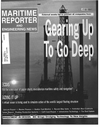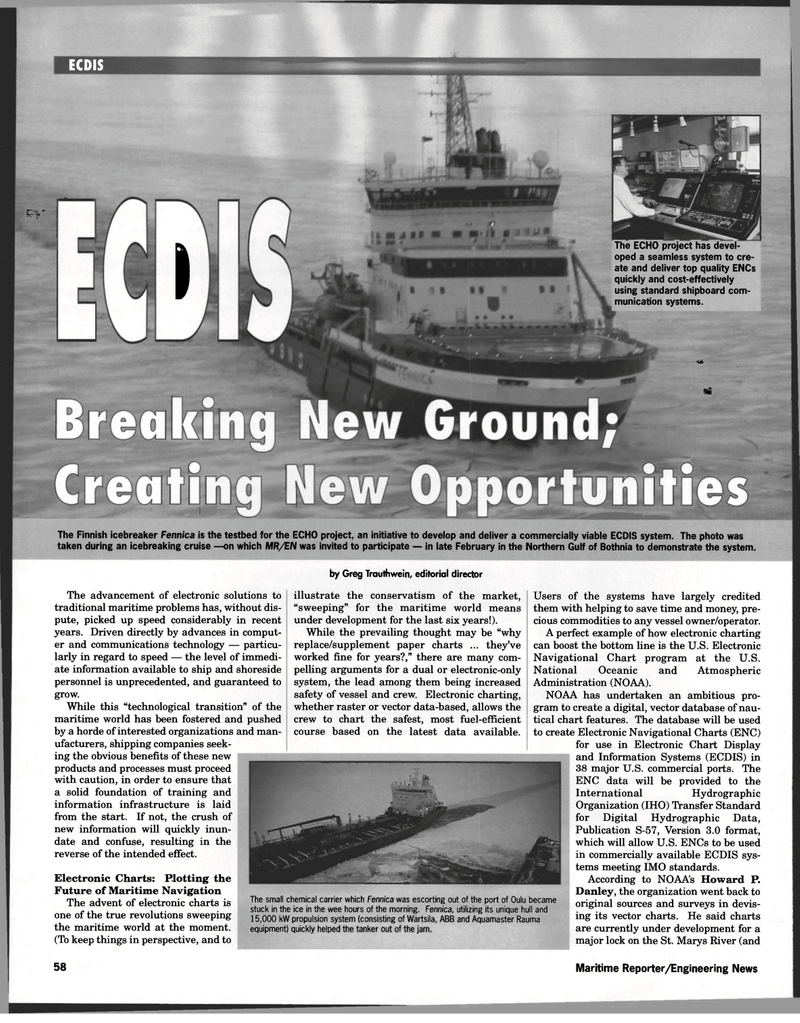
Page 66: of Maritime Reporter Magazine (April 1998)
Read this page in Pdf, Flash or Html5 edition of April 1998 Maritime Reporter Magazine
ECDIS
B *"
D The ECHO project has devel-oped a seamless system to cre-ate and deliver top quality ENCs quickly and cost-effectively using standard shipboard com-munication systems. mwmm • •
The Finnish icebreaker Fennica is the testbed for the ECHO project, an initiative to develop and deliver a commercially viable ECDIS system. The photo was taken during an icebreaking cruise —on which MR/EN was invited to participate — in late February in the Northern Gulf of Bothnia to demonstrate the system.
The advancement of electronic solutions to traditional maritime problems has, without dis- pute, picked up speed considerably in recent years. Driven directly by advances in comput- er and communications technology — particu- larly in regard to speed — the level of immedi- ate information available to ship and shoreside personnel is unprecedented, and guaranteed to grow.
While this "technological transition" of the maritime world has been fostered and pushed by a horde of interested organizations and man- ufacturers, shipping companies seek- ing the obvious benefits of these new products and processes must proceed with caution, in order to ensure that a solid foundation of training and information infrastructure is laid from the start. If not, the crush of new information will quickly inun- date and confuse, resulting in the reverse of the intended effect. by Greg Trauthwein, editorial director illustrate the conservatism of the market, "sweeping" for the maritime world means under development for the last six years!).
While the prevailing thought may be "why replace/supplement paper charts ... they've worked fine for years?," there are many com- pelling arguments for a dual or electronic-only system, the lead among them being increased safety of vessel and crew. Electronic charting, whether raster or vector data-based, allows the crew to chart the safest, most fuel-efficient course based on the latest data available.
Electronic Charts: Plotting the
Future of Maritime Navigation
The advent of electronic charts is one of the true revolutions sweeping the maritime world at the moment. (To keep things in perspective, and to
The small chemical carrier which Fennica was escorting out of the port of Oulu became stuck in the ice in the wee hours of the morning. Fennica, utilizing its unique hull and 15,000 kW propulsion system (consisting of Wartsila, ABB and Aquamaster Rauma equipment) quickly helped the tanker out of the jam.
Users of the systems have largely credited them with helping to save time and money, pre- cious commodities to any vessel owner/operator.
A perfect example of how electronic charting can boost the bottom line is the U.S. Electronic
Navigational Chart program at the U.S.
National Oceanic and Atmospheric
Administration (NOAA).
NOAA has undertaken an ambitious pro- gram to create a digital, vector database of nau- tical chart features. The database will be used to create Electronic Navigational Charts (ENC) for use in Electronic Chart Display and Information Systems (ECDIS) in 38 major U.S. commercial ports. The
ENC data will be provided to the
International Hydrographic
Organization (IHO) Transfer Standard for Digital Hydrographic Data,
Publication S-57, Version 3.0 format, which will allow U.S. ENCs to be used in commercially available ECDIS sys- tems meeting IMO standards.
According to NOAA's Howard P.
Danley, the organization went back to original sources and surveys in devis- ing its vector charts. He said charts are currently under development for a major lock on the St. Marys River (and 58 Maritime Reporter/Engineering News

 65
65

 67
67
